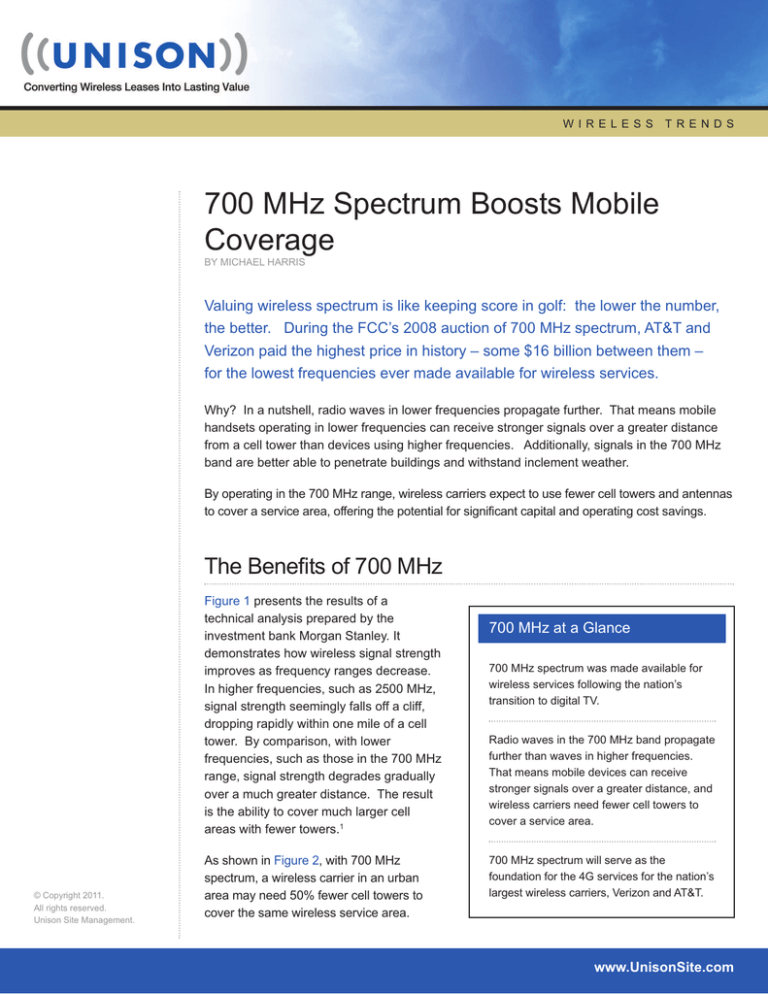
WI R E L E S S
T RE N D S
700 MHz Spectrum Boosts Mobile
Coverage
BY MICHAEL HARRIS
Valuing wireless spectrum is like keeping score in golf: the lower the number,
the better. During the FCC’s 2008 auction of 700 MHz spectrum, AT&T and
Verizon paid the highest price in history – some $16 billion between them –
for the lowest frequencies ever made available for wireless services.
Why? In a nutshell, radio waves in lower frequencies propagate further. That means mobile
handsets operating in lower frequencies can receive stronger signals over a greater distance
from a cell tower than devices using higher frequencies. Additionally, signals in the 700 MHz
band are better able to penetrate buildings and withstand inclement weather.
By operating in the 700 MHz range, wireless carriers expect to use fewer cell towers and antennas
to cover a service area, offering the potential for significant capital and operating cost savings.
The Benefits of 700 MHz
Figure 1 presents the results of a
technical analysis prepared by the
investment bank Morgan Stanley. It
demonstrates how wireless signal strength
improves as frequency ranges decrease.
In higher frequencies, such as 2500 MHz,
signal strength seemingly falls off a cliff,
dropping rapidly within one mile of a cell
tower. By comparison, with lower
frequencies, such as those in the 700 MHz
range, signal strength degrades gradually
over a much greater distance. The result
is the ability to cover much larger cell
areas with fewer towers.1
© Copyright 2011.
All rights reserved.
Unison Site Management.
As shown in Figure 2, with 700 MHz
spectrum, a wireless carrier in an urban
area may need 50% fewer cell towers to
cover the same wireless service area.
700 MHz at a Glance
700 MHz spectrum was made available for
wireless services following the nation’s
transition to digital TV.
Radio waves in the 700 MHz band propagate
further than waves in higher frequencies.
That means mobile devices can receive
stronger signals over a greater distance, and
wireless carriers need fewer cell towers to
cover a service area.
700 MHz spectrum will serve as the
foundation for the 4G services for the nation’s
largest wireless carriers, Verizon and AT&T.
www.UnisonSite.com
WI R E L E S S
T RE N D S
700 MHZ SPECTRUM BOOSTS MOBILE COVERAGE
PAGE 2
Fewer towers mean lower capital and
recurring expenditures for wireless
carriers.2
Verizon antenna for 700
Mhz/LTE site
Carrier Plans
For the nation’s two largest wireless
carriers, AT&T and Verizon, 700 MHz
spectrum will serve as the foundation for
fourth-generation (4G) wireless services
using a technology called LTE. Data, not
voice services, account for the majority of
traffic on wireless carrier networks today.
Their goal with 4G is to dramatically boost
data capacity and speeds for users as
efficiently and cost-effectively as possible.
FIGURE 1: Cell Tower Signal Strength
In the coming years, AT&T and Verizon are
expected to overlay their entire nationwide
networks with LTE infrastructure operating
in 700 MHz spectrum. In October 2010,
Verizon announced plans to launch LTE
service in 38 major metropolitan areas by
year’s end, including New York City, Los
FIGURE 2: Cell Site Coverage by Frequency
Angeles, Chicago, Boston, Seattle, San
Francisco and Washington, DC. Verizon says it will offer 700 MHz LTE coverage to more than
110 million Americans by the end of 2010, and full nationwide coverage in 2013.
qÜÉ ÄáÖ íÜáåÖ Ñçê ìë áë íÜ~í NMMB çÑ íÜÉ TMM jeò ëéÉÅíêìã
ïÉ ïçå áå íÜÉ c`` ~ìÅíáçå ~ ÅçìéäÉ óÉ~êë Ä~Åâ ïáää ÄÉ ìëÉÇ
Ñçê Qd ëÉêîáÅÉëK qÜÉ TMM jeò ëéÉÅíêìã ÖáîÉë ìë íêÉãÉåÇçìë
éêçé~Ö~íáçå ~Çî~åí~ÖÉë îÉêëìë íÜÉ éÉçéäÉ ïÜç ~êÉ
ÇÉéäçóáåÖ iqb áå íÜÉ ÜáÖÜÉê ëéÉÅíêìã ê~åÖÉëK TMM jeò
ëéÉÅíêìã ãÉ~åë íÜ~í íÜÉêÉ ïáää ÄÉ ÑÉïÉê ëáíÉë êÉèìáêÉÇ ~åÇ
ïÉDää Ü~îÉ ÄÉííÉê ÄìáäÇáåÖ éÉåÉíê~íáçåKÒ
Tony Melone, Executive Vice President and Chief Technology Officer, Verizon Wireless
© Copyright 2011.
All rights reserved.
Unison Site Management.
www.UnisonSite.com
WI R E L E S S
T RE N D S
700 MHZ SPECTRUM BOOSTS MOBILE COVERAGE
PAGE 3
AT&T plans to begin 700 MHz LTE network tests in 2010 and limited deployments starting in
2011 in anticipation of a wider rollout.
The rollout of 4G networks using LTE and 700 MHz will take time, but that’s par for the course
in the wireless world. In the meantime, carriers will continue to operate their 2G (secondgeneration) and 3G (third-generation) networks for voice and legacy data service delivery, while
migrating customers to LTE as they upgrade to 4G devices.
Notes
1,2
3
“The Mobile Internet Report,” Morgan Stanley Research, December 2009
Interview with Network World, February 2010
(www.networkworld.com/news/2010/022510-verizon-lte-melone.html)
About the Author
Michael Harris is principal consultant at Phoenix, Ariz.based Kinetic Strategies, Inc. Applying more than 15
years of experience as a strategist, research analyst,
journalist, public speaker and entrepreneur, Michael
consults with select clients in the networking, Internet
and telecommunications industries.
About Unison Site Management
Unison Site Management is the largest independently
owned cell site management company in the United
States, managing thousands of wireless leases. As
wireless lease consultants, Unison helps cell site owners
protect against uncertainty, maximize return and provide
peace of mind.
340 Madison Avenue,
New York, NY 10173
Phone: 1-866-434-8495
educate@so.unisonsite.com
© Copyright 2011.
All rights reserved.
Unison Site Management.
www.UnisonSite.com


